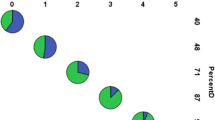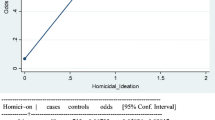Abstract
Although much of the research has focused on male delinquents, females are increasingly involved in violent crimes. We investigated factors that may be related to recidivism among delinquent females committed to a state correctional facility. The records of 238 female delinquents were examined and 96 were found to be recidivists. Our findings were consistent with previous research showing that age at first offense and first commitment differentiated recidivists from non-recidivists. Additional discriminant factors included deficits in basic math skills, gang affiliation, abuse, location of residence, and length of stay at the facility.
Similar content being viewed by others
REFERENCES
Balthazar, M. L., & Cook, R. J. (1984). An analysis of the factors related to the rate of violent crimes committed by incarcerated female delinquents. Journal of Offender Counseling, Services, & Rehabilitation, 9, 103-118.
Brunner, M. (1993). Reduced recidivism and increased employment opportunity through research-based reading instruction. Department of Justice, Washington, DC: Office of Juvenile Justice and Delinquency Prevention.
Calhoun, G., Jurgens, J., & Chen, F. (1993). The neophyte female delinquent: A review of the literature. Adolescence, 28, 461-471.
Dembo, R., Williams, L., Wothke, W., Schmeidler, J., & Brown, C. H. (1992). The role of family factors, physical abuse, and sexual victimization experiences in high-risk youth's alcohol and the other drug use and delinquency: A longitudinal model. Violence and Victims, 7, 245-266.
Doren, B., Bullis, M., & Benz, M. R. (1996). Predicting the arrest status of adolescents with disabilities in transition. The Journal of Special Education, 29, 363-380.
Fejes-Mendoza, K., Miller, D., & Eppler, R. (1995). Portraits of Dysfunction: Criminal, educational, and family profiles of juvenile female offenders. Education and Treatment of Children, 18, 309-321.
Hamilton, S. F. (1986). Raising standards and reducing dropout rates. Teacher's College Record, 87, 410-429.
Katsiyannis, A., & Williams, B. (in press). A national survey of state initiatives on alternative education. Remedial and Special Education.
Katsiyannis, A., & Archwametv, A. (1997). Factors related to recidivism among delinquent youths in a state correctional facility. Journal of Child and Family Studies, 6, 43-55.
Kauffman, J. M. (1995). Characteristics of emotional and behavioral disorders of children and youth (5th ed.). New York: Merrill.
Klein, S. P., & Caggiano, M. N. (1986). The prevalence, predictability, and policy implications of recidivism. Santa Monica, CA: Rand.
Kroupa, S. E. (1988). Perceived parental acceptance and female juvenile delinquency. Adolescence, 23, 171-185.
Land, K. C., McCall, P., & Williams, J. R. (1990). Something that works in juvenile justice: An evaluation of North Carolina Court Counselor's Intensive Protective Supervision Randomized Experimental Project, 1987–1989. Education Review, 14, 574-606.
Laufenberg, R. (1987). Positive peer culture: A peer group approach to behavior change. Journal of Correctional Education, 28, 138-143.
Lawrence, R. (1985). School performance, containment therapy, and delinquent behavior. Youth and Society, 17, 69-95.
Leon, P., Rutherford, R., & Nelson, C. (1991). Special education in juvenile corrections. Reston, VA: The Council for Exceptional Children.
Leschied, A. W., Coolman, M., Jaffe, P., & Sas, L. (1986). The role of the family court clinic in the assessment of schoolrelated disorders with young offenders. Guidance & Counseling, 1, 19-24.
Macallair, D. (1993). Reaffirming rehabilitation in juvenile justice. Youth and Society, 25, 104-125.
Maguire, K., Pastore, A. L. (1995). Sourcebook of criminal justice statistics. Washington, DC: U.S. Printing Office.
Marshall, J. E. (1995). Street soldiers: Violence prevention over the airwaves, a phenomenon. Journal of Health Care for the Poor and Underserved, 6, 246-251.
Miller, D., Trapani, C., Fejes-Mendoza, K., Eggleston, C., & Dwiggins, D. (1995). Adolescent female offenders: Unique considerations. Adolescence, 30, 429-435.
Minor, K. K., & Elrod, H. P. (1990). The effects of a multifaceted intervention on the offense activities of juvenile probationers. Journal of Offender Counseling, Services, & Rehabilitation, 15, 87-108.
Moran, P. B., Davies, M. K., & Toray, T. (1994). Behavioral, emotional, and psychological outcomes among adolescents in a drug treatment program: A comparison of maltreated and non-maltreated youth. Journal of Child & Adolescent Substance Abuse, 4, 17-33.
Pollard, R. R., Pollard, C. J., & Meers, G. D. (1995). A sociological, psychological and educational profile of adjudicated youth with disabilities. Journal for Vocational Special Needs Education, 17, 56-61.
Rhodes, J. E., & Fischer, K. (1993). Spanning the gender gap: Gender differences in delinquency among inner-city adolescents. Adolescence, 28, 879-889.
Spellacy, F. J., & Brown, W. G. (1984). Prediction of recidivism in young offenders after brief institutionalization. Journal of Clinical Psychology, 40, 1070-1074.
Tannehill, R. L. (1987). Employing a modified positive peer culture treatment approach in a state youth center. Journal of Offender Counseling, Services, & Rehabilitation, 12, 113-129.
Traynelis-Yurek, E., & Giacobbe, G. A. (1989). Unremediated learning disabilities and reincarceration. Journal of Offender Counseling, Services, & Rehabilitation, 13, 163-174.
U.S. Department of Education (1996). Mini-digest of education statistics, 1994. Washington, DC: National Center for Education Statistics.
U.S. Department of Justice (1994). Uniform crime reports for the United States, 1993. Washington, DC: U.S. Government Printing Office.
Wierson, M., & Forehand, R. (1995). Predicting recidivism in juvenile delinquents: The role of mental health diagnoses and the qualifications or conclusion by race. Behavior Research and Therapy, 33, 63-67.
White, M. P. (1995). A comprehensive approach to violence prevention. Journal of Health Care for the Poor and Underserved, 6, 254-260.
Author information
Authors and Affiliations
Rights and permissions
About this article
Cite this article
Archwamety, T., Katsiyannis, A. Factors Related to Recidivism Among Delinquent Females at a State Correctional Facility. Journal of Child and Family Studies 7, 59–67 (1998). https://doi.org/10.1023/A:1022960013342
Issue Date:
DOI: https://doi.org/10.1023/A:1022960013342




